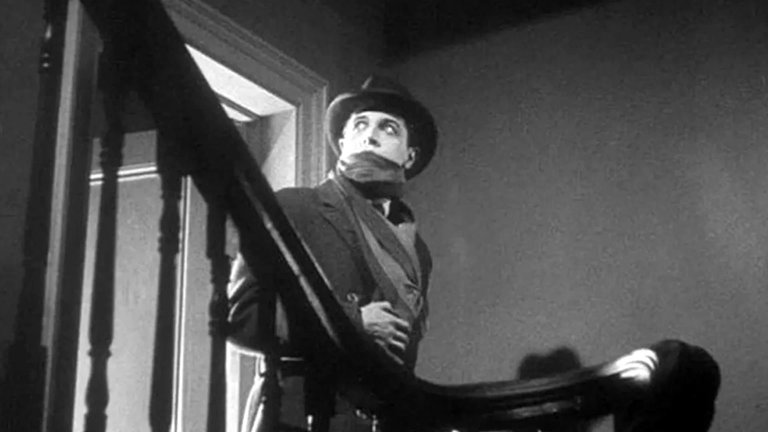Film Review: The Lodger: A Story of the London Fog (1927)

At the end of the silent era British cinema was, in term of general quality, way below Hollywood and grand cinema industries of Europe. Its honour was ultimately defended by young man whose time would actually come in next decades and who would become and one of the greatest names of world cinema. That man was Alfred Hitchcock, director whose third feature film, 1927 thriller The Lodger: A Story of the London Fog, is often considered to be the best British silent film ever.
The film is based on the eponymous 1913 novel by Marie Belloc Lowndness, which had been inspired by the series of unsolved murders attributed to Jack the Ripper. In 1915 the novel was adapted by Horace Annesley Vachell, Who is He?, comical stage play, which was seen by teenage Hitchcock. The plot begins one night when a blonde showgirl gets brutally murdered on the streets of London. We soon learn that the murder is just one in the series and that the unknown serial killer, is preying on women with golden-curled hair, striking every Tuesday night and leaving notes signed as “Avenger”. Protagonist Daisy Bunting (played by June Tripp) is showgirl and fashion model who fits such description, but she doesn’t seem to be too concerned, since her boyfriend Joe Chandler (played by Malcolm Keen) happens to be police detective assigned to the case. Daisy lives with her father (played by Arthur Chesney) and mother (played by Marie Ault), a couple that supplement their income by renting room. Their newest lodger is Jonathan Drew (played by Ivor Novello), handsome but secretive man whose looks fit newspaper description of the killer. Despite his strange behaviour at the start, he gradually wins favour of Daisy, but Mrs. Bunting becomes increasingly convinced that her lodger is actually “Avenger”.
The Lodger was Hitchcock’s third feature film. It represents a captivating blend of old-school melodrama characteristic for silent cinema and modern thriller, with many elements that would later become known as “Hitchcockian”. The latter is also a reason why it is often considered to be the first “true” Hitchcock’s film. While directing it, Hitchcock was under great influence of German Expressionism, but he also added personal touch, with dissolves, close-ups, and flashbacks, showcasing his early mastery of cinematic storytelling. The film introduces some of Hitchcock's signature themes such as the innocent man on the run, obsession with blondes, and the connection between voyeuristic sex and homicidal violence. One particularly suspenseful scene shows how Drew apparently tries to spy on Daisy while she is taking bath, Hitchcock’s foray into mild eroticism and precursor of the similar scene in Psycho. Hitchcock builds suspense throughout the film with success, creating a tense atmosphere that keeps viewers engaged, although at times there are issues with pacing, which, together with over-theatrical brand of acting, might annoy some of the viewers unaccustomed to silent cinema. However, it is the film's weak deus ex machina ending, which deprives The Lodger of becoming the top classic of its era.
In Hitchcock’s defence, it could be said that The Lodger was hardly an author’s film. Producer Michael Balcon has hired Ivor Novello, popular composer and songwriter who had recently found new career as matinee idol, and, despite all Hitchcock’s protestations, refused to make his character a villain. The script, instead, made rather unconvincing way of exonerating Drew in the last minute. Balcon was displeased by original version of Hitchock’s film, and almost had it shelved. Thankfully, film’s editor and part-time-critic film critic Ivor Montagu suggested some minor corrections (like the removal of many intertitles and few reshoots) and this version became big box office hit, thus guaranteeing continuation of Hitchcock’s career. Novello repeated the title role in 1932 sound remake directed by Maurice Elvey. In 1944 another version starring Laird Cregar was made in Hollywood, while in 1955 Hugo Fregonese directed another remake under title Man in the Attic, starring Jack Palance. In 2009 David Ondaatje wrote and directed another version set in Los Angeles.
RATING: 7/10 (+++)
Blog in Croatian https://draxblog.com
Blog in English https://draxreview.wordpress.com/
InLeo blog https://inleo.io/@drax.leo
Hiveonboard: https://hiveonboard.com?ref=drax
Rising Star game: https://www.risingstargame.com?referrer=drax
1Inch: https://1inch.exchange/#/r/0x83823d8CCB74F828148258BB4457642124b1328e
BTC donations: 1EWxiMiP6iiG9rger3NuUSd6HByaxQWafG
ETH donations: 0xB305F144323b99e6f8b1d66f5D7DE78B498C32A7
Posted using CineTV
